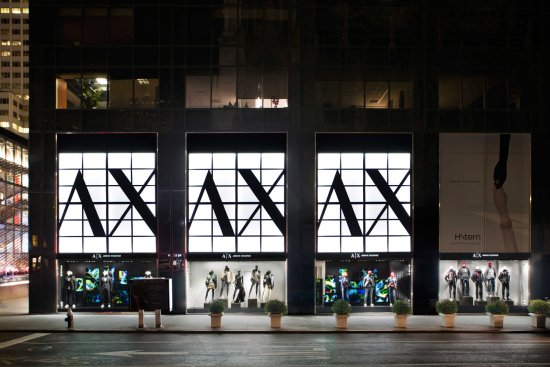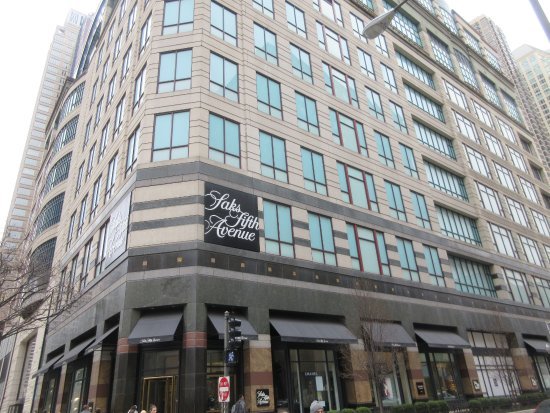TSI had a long but bumpy association with SFA. Continue reading
Saks Fifth Avenue (SFA) is more than just a store. For decades it has been a chain of high-end department stores throughout North America as well as numerous smaller affiliated stores. In the early nineties its headquarters was in its famous flagship store on Fifth Avenue in Manhattan. The first Saks store was opened in 1867, and for decades the enterprise was owned and operated by the Saks family. However, since 1923 Saks has been owned and controlled by outside organizations except for a two-year period beginning in 1996 when it was a public corporation. Even then 50 percent of the stock was retained by its previous owner, the Bahrain-based firm, Investcorp.
I, of course, was blissfully ignorant of most of this when, in the early nineties, TSI began pitching the AdDept system to the advertising department of Saks. In fact, my presentation to Saks may have been the first one that had a fairly serious chance of succeeding. I don’t remember the demo, but I surely gave one at the IBM office on Madison Avenue. I also definitely visited the office of the Saks’ advertising department, which at that time was on one of the upper floors of the store on Fifth Avenue to collect the requirements for the official proposal.
It did not take me long to realize that SFA was very different from Macy’s. The Senior VP at Saks was a woman, and her secretary was a man. I am embarrassed to report that I don’t remember either of their names. Theirs was an unusual setup in the early nineties. More surprising to me was the fact that around his desk were posted large glossy photographs of shirtless male models.
Saks’ advertising department was responsible for more than just the Fifth Avenue store. There were dozens of full-line stores that bore the SFA logo strategically positioned around the continent in locations with the requisite number of rich people. They also managed the little advertising done for even more Off Fifth outlet stores that sold the merchandise that had not been sold at the SFA stores. They also had responsibility for advertising for the Armani Exchange stores. I never quite understood why.
For me the most surprising thing about Saks’ approach to advertising was its focus on New York City. Macy’s focus was somewhat similar, but their primary purpose in purchasing AdDept was to be able to hand additional markets. Saks divided their SFA stores into two groups: New York and OTS, which stood for “out-of-town stores.” Their newspaper advertising was heavily focused on the New York Times. They may have used Newsday for the Long Island store, but I don’t think that they used the other tabloids at all.
Saks also advertised very heavily in fashion magazines. In some ways the system could treat magazines as newspapers that only published one issue per month, but in other ways they were quite different. A fair amount of programming was required to handle Saks’ advertising in Vogue and other such periodicals.
Saks signed a contract with TSI in 1994, which was a banner year for the company. I made sure that all of the users of and prospects for the AdDept system knew that Saks was now on our client list by including the news in an issue of Sound Bytes, TSI’s short-lived newsletter.
At Saks Fifth Avenue, the national retailer based in Manhattan, the implementation of the AdDept system is scheduled for May 1. Advertising personnel will be connected to an AS/400 located at the company’s data center in Lawrenceville, NJ, through a Token Ring network. Both Mac and PC users in all areas of the department and the advertising business office will have access to the data. In addition to the wealth of standard features in AdDept, custom programming will provide the department with the ability to produce advertising schedules by store, to track advertising expenses (gross, vendor, and net) by merchandise vendor, and to produce change reports that conform with the way that the department is organized.
Reading this blurb again brought to mind a few unusual aspects concerning the installation.
- I made at least one trip to Lawrenceville, which is closer to Philadelphia than to Fifth Avenue, probably at the time when the AS/400 was installed in 1994. Almost never did anyone from TSI deal with anyone from that facility, and they had never had a hardware problem. However, several years later we received a very strange phone call from someone there who requested that someone from our office dial into the system over the modem. They said that no one could remember where they had put it; they hoped that the noise produced by the modem—it never answered on the first ring—would lead them to it. Apparently it worked. In 1998 all of Saks’ computers were moved to the Proffitt’s Inc. facility in Jackson, MI. I installed a newer faster machine there.
- My recollection is that Saks used very little of the custom programming that TSI had coded and implemented at the time of the installation until Tom Caputo arrived eight years later. They mainly used the AdDept system as an easier way to key in expenses for their accounts payable and general ledger systems, which AdDept was designed to feed.
- The phrase “the way that the department is organized,” brought back memories of the difficulties that I encountered while training at SFA. The ROP (i.e., newspaper ads) manager, in particular, was quite uncooperative in helping me understand how she worked. She evidently considered ROP her own little fiefdom, and suspected that revealing the knowledge of how her area worked might affect her job security. This was by no means the last time that I was faced with this sort of heel-dragging.
I remember a few other details about that initial installation:
- I heard one interesting story related by an employee at Saks. The person at the headquarters who monitored sales by store had been very concerned because the Beverly Hills store in California had in the previous few months posted much lower sales than expected. A call to the store manager revealed a simple explanation: “The princess died.” Evidently a Saudi princess had been purchasing so much so regularly from the store that her untimely demise had dramatically deflated the the store’s total revenues.
- Once or twice I spent consecutive days in Manhattan during the installation. Saks arranged for me to stay in a luxurious room at the nearby Sheraton. It was by far the nicest place in which I ever stayed for business.
- I remember that on one occasion SFA had asked for a day of training, for which TSI charged $1,000. I discovered when I arrived in Manhattan that no one who actually used (or had any intention of using) the AdDept system was available to spend time with me. So, for several hours I “trained” three interns. For all of them English was a second language. One was named Oscar; I don’t remember the other names.
In subsequent years I was not a bit happy with the state of the installation at Saks. It made me realize that the success of our installations was largely dependent upon the strength of our liaison. The person needed to have the ability to grasp the intricacies of the system, a personality adaptable to working with both TSI and the users of the system, and the clout (direct or indirect) to deal with problems once they had been identified.
I very much wanted to use Saks as a reference account, but they used so little of the system that I was reluctant to mention them. I was frankly puzzled as to why it seemed so difficult to get anyone outside of the finance area interested in making the system work for them. The person with whom we worked the most was Jeanette Igesias1. She was conscientious enough, but she had neither the authority nor the inclination to involve any of the other areas more fully.
In 1998 the retail world was shocked to learn that Saks Holdings, Inc., the parent company, had been acquired by Proffitt’s Inc.2, a company that a few years earlier consisted of a set of stores in Tennessee that could have all fit easily inside the Saks store on Fifth Avenue. Almost immediately after the acquisition the parent company’s name was changed to Saks Inc.
Shortly thereafter I was in Birmingham, AL, to work with employees of the advertising department for the Parisian3, a chain of department stores that Proffitt’s Inc. had previously acquired. The corporate headquarters was also located in the same building. I happened to encounter the same Senior VP from Saks’ adverting department whom I had met in the early nineties. She was there to meet with people from what was then still called Proffitt’s Marketing Group (PMG). She knew that I had been frustrated with the pace of the installation at SFA. She even remarked that maybe under the new ownership they could get something done.
At about this time Ava John was hired by Saks. I think that she worked under Jeanette until Jeanette left SFA in 2002. Thereafter Ava was TSI’s principal contact for the part of the system used by the advertising business office, which included recording invoices that were uploaded to the corporate accounts payable system.
In 2008 Ava was arrested and charged with running an embezzlement scheme that netted her and her friends and relatives more than $680,000 over the course of five years. That may seem like a lot, but it was only a little over $10,000 per month, a tiny fraction of what Saks spent on advertising. I discovered a single mistake at another installation that was about as large as this.
At the time I did not hear about any of this, and, to the best of my knowledge, neither did any of TSI’s employees, but the scandal was reported in all three of New York’s major dailies. The Post‘s coverage can be read here. I was unable to discover anything posted on the Internet about the ultimate legal resolution. I also know nothing more about Ava.
In 2001 Tom Caputo, who had been TSI’s primary contact at Lord &Taylor5 for several years, was hired by Saks. He had a number of responsibilities in the advertising department, one of which was to oversee the AdDept installation. Tom’s office was not in the flagship store, but in an office building across the street. I met with him there several times. I cannot remember what projects we did for them, but I remember that Tom seemed frustrated with the situation there, or, more likely with what the world of retail had become in the twenty-first century.
Tom stayed at Saks until 2014, the same year that Denise Bessette and I decided to shut down TSI. I had one further contact with him. He asked me if I knew of any job openings that he would qualify for. I had to reply in the negative. By that time the demand for both people and software that was adept at administering the advertising for large national retailers was negligible. I felt sorry for my many acquaintances who were not able to disassociate themselves from this undertaking as smoothly as we did.
In 2007 Saks was spun off from the other department stores that were part of Saks Inc. The executive who had cobbled together this retail giant, R. Brad Martin, summarily abandoned the leadership of the rest of the stores to someone else and elected to run just SFA. His decision to remove the jewel from the crown was described in this New York Post. article.
In 2013 the company was purchased by the Hudson Bay Company, the oldest corporate enterprise in North America. The company had already purchased Tom Caputo’s previous employer, Lord & Taylor. One of the last projects that I worked on at TSI was helping with the migration of SFA’s AdDept system to the HBC computers located somewhere in Canada.
There are still many Saks Fifth Avenue stores. HBC opened a huge store in Toronto in 2014 and at least two other stores in Canada. Administration of all of the stores seems to be split between Toronto and New York.
1. Jeanette Iglesias’ LinkedIn page can be found here.
2. Much more about TSI’s relationship with Proffitt’s Inc./Saks Inc. is available here.
3. Details about the Parisian installation of the AdDept system are provided here.
4. You can read about this major boo-boo here.
5. The history of the AdDept installation at Lord & Taylor is documented here.









